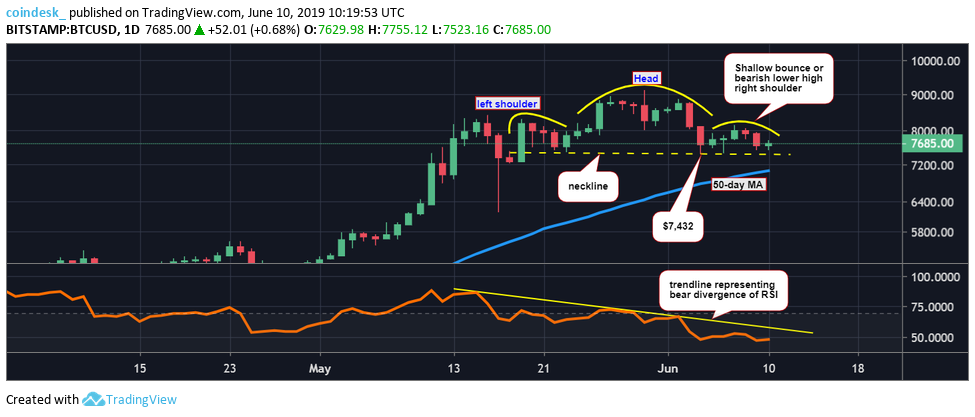Volatility? What volatility? Where did it go? Suddenly Bitcoin seems to have forgotten its most identifying trait, to be the most volatile asset class in history. For the past thirty days, there have been several fits and starts, but the world’s favorite cryptocurrency has displayed fairly stable price behavior of late, as if Bulls and Bears had tired of the fight. Within the past week, BTC has managed to stick within a fairly tight trading corridor between $7,500 and $8,100. At this moment, it is at $7,940, still $700 above its 50-Day Moving Average, while analysts contemplate the next direction.
The analyst community at present is an edgy lot. There have been so many creditable pronouncements that a 30%+ correction was imminent that analysts have been reticent to boast of any dramatic predictions. The sensitivity that a sudden downdraft might overtake the market is fresh in everyone’s mind. The G20 financial ministers just adopted some draconian crypto “anti-anonymity” guidelines after their meeting in Japan, and right after their announcement, Bitcoin fell $500 in response. In their rush to publish, however, many of the frightened missed the full recovery over the next few hours.
The following chart is one case in point:
The chart is pre-recovery, but in a way, it demonstrates the uneasiness that permeates the analysts’ community at the moment. The “Head-and-Shoulders” pattern is a favorite in the world of Technical Analysis. The joke amongst veteran traders is that beginners often see the familiar “H&S” formation everywhere. The odds favor a downdraft the size of the distance between the “Neckline” and the “Head”, or, if you do the math, Bitcoin, by this analyst’s reckoning, could fall as low as $5,800, before finding adequate support.
The analyst, Omkar Godbole, who prepared the above chart and to his credit, also made mention of counter points to his bearish theory. First, the RSI, although displaying a “bear divergence”, is in oversold territory. A move up would counter his hypothesis, as does the 50-Day MA being far below current pricing. Lastly, the analyst admits: “Even so, it is still too early to call a bearish reversal as BTC is yet to confirm the most basic of all bearish chart patterns, a paired lower high and lower low.” Suffice it to say that if Bitcoin closed below $7,432 once or possibly twice, the next stop might be the 50-Day MA at roughly $6,800, and then who knows how much lower.
Another crypto analyst, who goes by the social media moniker of “Financial Survivalist”, echoed Godbole’s sentiments on Twitter: “#Bitcoin is testing a crucial area of support from the 200 EMA (4h) & previous horizontal. If we continue to close above $7,615 then we should eventually breakthrough the top of the channel & continue the bull trend. If we break down $7,500 then I’ll be setting bids at $6,800.”
As we noted in the prologue, Bitcoin has recovered nicely. The view for the week ahead remains “neutral” per a majority of thought pieces in the press. The general concern is one of bull exhaustion. After BTC assaulted $9,000 two weeks back, Godbole observed:
The doji candle and the bearish follow-through indicate the period of indecision or exhaustion in the market place has ended with the bears victorious.
Not all crypto analysts have suddenly turned cautious and pessimistic. John Isaacs, millionaire cryptocurrency analyst and trader, believes the “safe haven” aspect of Bitcoin has come to the fore in recent weeks, due to trade war tensions and the fear that a slowing global economy might lead to recession. Equities had been in a general down trend, and several global investors were looking to hedge their bets with cryptos.
During a recent interview, which followed on the heels of Bitcoin’s apparent meltdown after crossing over $9,000, Isaacs shared this opinion publicly:
I believe bitcoin has the potential to hit $25,000 by the end of 2019 or early 2020. There are multiple drivers behind the recent resurgence. There are geopolitical, technological, and regulatory drivers. The net effect of the trade war between the U.S. and China has led to a sudden interest in bitcoin as a hedge on investments.
The analyst community is at another Bitcoin crossroads, where ambivalence rules with regard to what the next destination might be. An old trading adage states: “The longer the ranging period, the larger the force of the breakout.” The odds favor the direction that preceded the ranging period, but the past is no guarantee of future price behavior.

